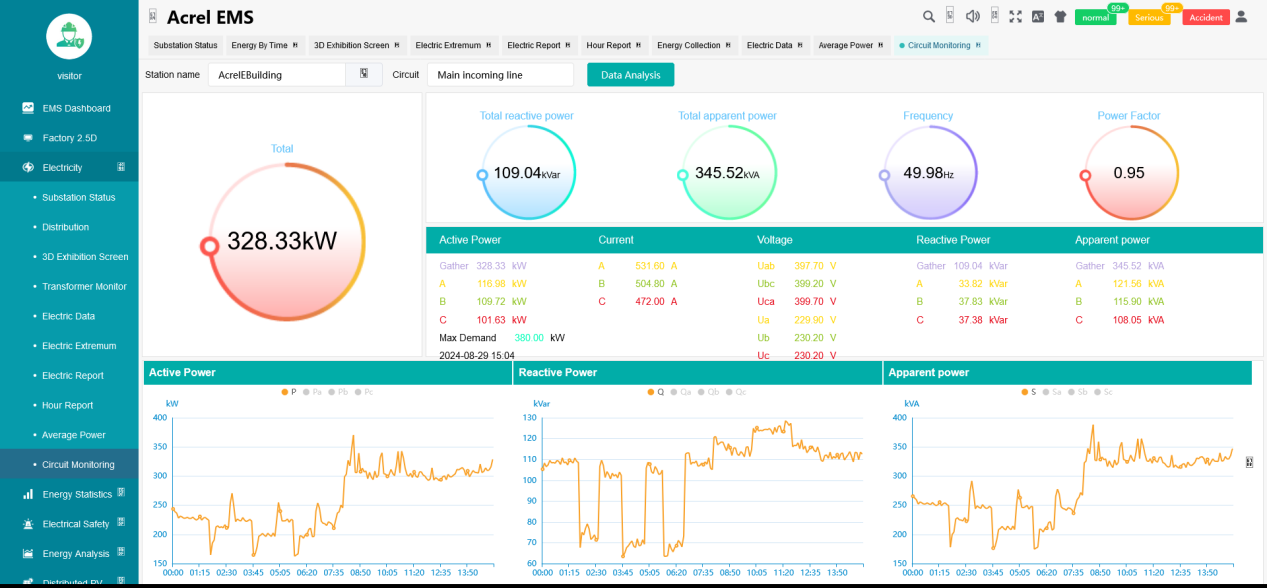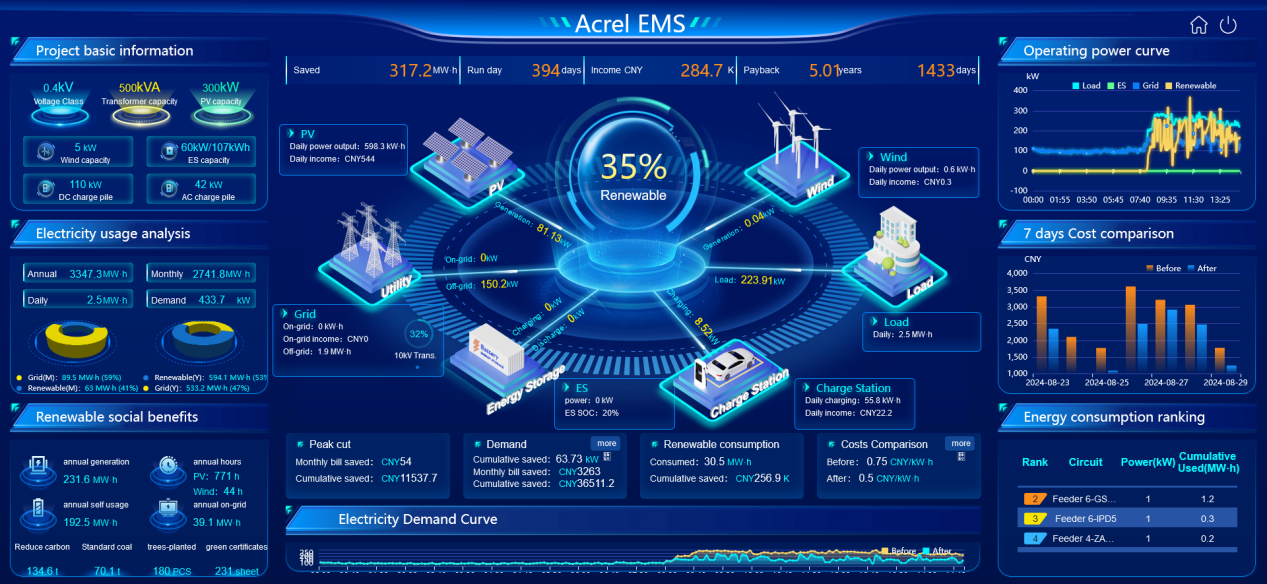Data center Introduction
Data centers are one of the indispensable infrastructures in modern society. They carry various key businesses and applications, such as cloud computing, big data, and artificial intelligence. However, the energy consumption of data centers is very high. It is estimated that the energy consumption of global data centers accounts for about 2% of the world’s total energy consumption. In order to deal with this problem, data centers need to take comprehensive energy efficiency management measures to reduce energy consumption, improve resource utilization, and reduce operating costs. Acrel comprehensive energy efficiency management solution for data centers is born for this purpose. It combines multiple technical means such as physical equipment management, environmental monitoring, energy management, and intelligent optimization to help data centers achieve reliable and sustainable operations.
• Improve energy efficiency: Data centers are high-energy consumption places and have high requirements for the effective use of energy. Users hope to use this solution to monitor the energy consumption of data centers in real time, find out the problem of energy waste, and take corresponding measures to improve energy efficiency, reduce energy consumption, and reduce operating costs.
• Ensure the stability and reliability of power supply: Data centers have high requirements for the stability and reliability of power supply. Users hope to use power monitoring and UPS battery monitoring functions to monitor power parameters and UPS battery status in real time, detect power failures and UPS battery problems in time, and handle them accordingly to ensure continuous and stable power supply of the data center and avoid service interruptions and data loss. • Ensure power quality: Power quality has a direct impact on the operating stability and life of data center equipment. Users hope to use power quality monitoring and governance functions to timely detect and solve power quality problems, such as voltage fluctuations and current harmonics, to ensure the normal operation of data center equipment and stable power quality.
• Improve environmental safety: Data center environmental safety is crucial to the protection of equipment and data. Users hope to use environmental monitoring functions to monitor data center parameters such as temperature, humidity and flooding in real time, detect environmental anomalies and potential flooding events in time, and warn and take measures to prevent safety risks.
• Intelligent remote management: Data centers are often distributed in different locations, and users need an intelligent remote management method. The solution provides remote monitoring and access functions, allowing users to remotely view the operating status of the data center through devices such as mobile phones, tablets or computers, conduct data analysis and troubleshooting, and improve the convenience and flexibility of management.
• Data analysis and optimization: Users hope to conduct energy efficiency evaluation and optimization through the recording and analysis of data such as power monitoring, power quality monitoring, UPS battery monitoring and environmental monitoring, find the bottleneck of energy consumption, formulate a reasonable energy efficiency improvement plan, and continuously improve the energy efficiency and comprehensive energy efficiency performance of the data center.
Project Introduction
The data center project is located in Inner Mongolia and is a large cloud computing and data storage base. The total investment of the project is about 2 billion yuan, covering an area of about 500,000 square meters and a total construction area of about 150,000 square meters. The construction of the project is divided into two phases. The first phase has been put into use in 2021, and the second phase is under construction. The data center project has energy-saving physical equipment, intelligent environmental monitoring and energy management systems, and a flexible and scalable business processing platform. The construction of this project aims to provide safe and reliable data processing and storage services for governments, enterprises and individual users, and promote the development and transformation and upgrading of the local digital economy. At the same time, the project will also bring new opportunities and impetus to local economic development and promote local informatization construction and industrial upgrading.
Application Solution Based on its deep understanding of data center power distribution systems and energy management over the years, Acrel has launched the AcrelEMS-IDC Data Center Comprehensive Energy Efficiency Management System Solution for data center energy management construction. It can assist data center managers in the operation and management of energy supply systems and equipment, and help data center management to understand the energy consumption of data centers in real time, providing a good technical platform and data support for data center energy information construction and energy conservation management. AcrelEMS-IDC Data Center Comprehensive Energy Efficiency Management System provides monitoring and control for data center energy management, mainly including power monitoring, power quality monitoring and management, energy consumption analysis, battery online monitoring and management and other functions, aiming to realize intelligent management of data centers, improve energy utilization efficiency, ensure the stability and reliability of power supply, ensure power quality and environmental safety, and realize remote intelligent management and data analysis optimization, thereby reducing operating costs, improving the comprehensive energy efficiency performance of data centers, and promoting the sustainable development of data centers.
• Power monitoring. Real-time monitoring of the operating conditions of substations, substation switchgear, transformers, emergency power supplies and major power-consuming equipment, and collection of data from microcomputer protection and measurement and control devices, including electrical parameters, switch status, remote control, accident alarms and records, etc.;b. Monitoring the power quality of each incoming line circuit, including waveform recording of voltage sag, harmonic distortion, flicker and other data, and then determining the direction of the distribution system disturbance and generating a power quality analysis report;c. Performing functions such as fault recording and event sequence recording on medium and high voltage circuits to assist in analyzing the cause of the fault and improving it;d. Installing arc protection devices on the busbars of medium voltage switchgear, and detecting faulty arcs to quickly trip and alarm;e. Monitoring the electrical parameters and switch status of 0.4kV feeders, and temperature monitoring of cable joints, circuit breaker contacts, low-voltage and high-current equipment in the switchgear;f. Performing power quality management on 0.4kV, including harmonic management and reactive power compensation.
• Power quality monitoring and control
a. Online real-time monitoring of the power quality of the data center distribution system can timely capture and handle the voltage surge, sag, and short-term interruption in the distribution system. Scientifically analyze the voltage and current of the distribution system to reflect the current power quality in a more timely, accurate, and sensitive manner, and reduce the losses caused by power grid fluctuations;
b. Harmonic control of the power quality of the data center distribution system to reduce the harm and impact of harmonics;
c. Reactive compensation of the power quality of the data center distribution system to improve the overall power utilization efficiency.
• UPS battery monitoring a. Monitor the voltage of the battery pack to ensure that the voltage of the battery pack is within the normal range. By real-time monitoring of the battery voltage, abnormal or attenuated battery pack voltage can be detected in time so that appropriate measures can be taken; b. Monitor the temperature of the battery pack to ensure that the temperature of the battery pack is stable and within a safe range. Excessive temperature may affect the battery life and performance, so by monitoring the battery temperature, potential problems can be discovered and solved in time; c. Monitor the capacity of the battery pack to understand the remaining capacity and attenuation of the battery pack. By monitoring the battery capacity in real time, the battery life and performance can be predicted, and whether battery maintenance or replacement is required; Battery internal resistance monitoring: Monitor the internal resistance of the battery pack to evaluate the status and performance of the battery pack. Internal resistance is an important indicator of battery attenuation and performance degradation. By monitoring the internal resistance of the battery, battery failure or degradation can be detected early; d. Monitor the charge and discharge current of the battery pack to understand the charge and discharge status and performance of the battery pack. By monitoring the charge and discharge current of the battery, the operating status of the battery pack can be evaluated to ensure the safety and stability of the charging and discharging process;
• Environmental monitoring
a. Real-time monitoring of temperature changes in the data center computer room, and obtain environmental temperature data through temperature sensors. Provide temperature curves and historical data to help data center administrators understand the changing trends and periodic changes of the room temperature.
b. Real-time monitoring of humidity changes in the data center computer room, and obtain environmental humidity data through humidity sensors. Provide humidity curves and historical data to help data center administrators understand the changing trends and humidity fluctuations of the computer room humidity.
c. Install water immersion sensors to monitor whether there are water immersion events in the computer room in real time. When flooding occurs, the system will immediately send out an alarm to notify relevant personnel so that timely measures can be taken to avoid equipment damage and safety risks.
d. Equipped with real-time alarm function, once environmental parameters such as temperature, humidity or flooding exceed the preset range, the system will automatically send out an alarm to notify the data center administrator.
e. Record environmental data and provide storage and analysis functions for historical data. Administrators can view historical temperature and humidity change trend charts and analyze the stability and changes of the computer room environment in order to optimize environmental management strategies.
Post time: Oct-29-2024






